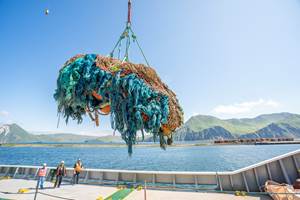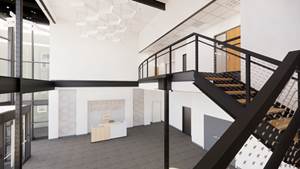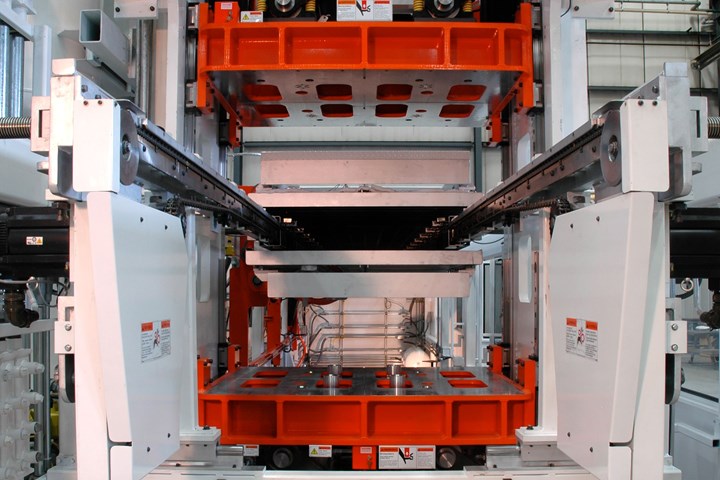
Shown above is the dual-servo index system on Brown Machine’s continuous thermoformer.
It is possible to maintain a thermoforming machine’s performance at high levels across the equipment’s lifetime through careful maintenance and regular adjustments, as well as targeted troubleshooting when issues occur. Among these measures, operator adjustments are more important than ever, since travel and building occupancy restrictions put in place to minimize the spread of COVID-19 make it more difficult for OEM maintenance teams to access equipment installed in plants.
The good news is that just a small number of regular adjustments can make a major difference in thermoforming performance. What’s more, when issues arise, a checklist of 10 possible problems and solutions can help to resolve all but the trickiest thermoforming concerns. With this information, operators can maintain equipment and keep it running smoothly day to day and year to year.
Just a small number of adjustments can make a major difference in thermoforming performance.
Rail Adjustments
Basic rail adjustments throughout thermoforming equipment’s lifetime help to ensure peak performance and avoid issues from surfacing. A few major adjustments that should be made regularly—more regularly than most operators expect, in order to prevent performance issues:
• First, operators should regularly check the rail and tool alignment and make minor adjustments as necessary. Rails must start parallel to the mold, and there should be 3/8 to ½ in. per side between the rails and the mold. If the rails are too close to the mold, damage to the mold and chain rails may occur. Issues in these alignments are common, so remember to check and adjust before major performance problems begin to occur.
• Another adjustment to be monitored is the height of cooling tubes, especially if materials are being changed regularly. The standard wisdom is that cooling tubes should be set to the material thickness plus 0.020 to 0.030 in. But if using materials thinner than 0.030 in., setting the cooling tubes with this much clearance will cause issues. Instead, set the cooling-tube height equal to a double layer of these thinner materials. If set too high, rippling in the sheet known as webs can occur as the material lifts off of the pin chain and is folded over. If the cooling-tube height set too low, the cooling tubes cause excess drag, and dust is produced.

• Finally, chain adjustments are necessary to keeping up reliable performance. Wear and stretching of the chain at uneven rates can lead to issues with shot alignment and tracking. Such wear and stretching are natural over time and might be worsened by the sheet pulling or melting unevenly. Chain tension should also be checked regularly, as it must be equal in both chains. If tension is too loose, there may be ripples and alignment issues; if it is too tight, there can be excess wear on sprockets and wear bars. Mechanical tensioners are inconsistent compared with pneumatic ones, but even pneumatic tensioners can result in uneven tension if not checked appropriately. Chains should be replaced as needed when stretching or wear occurs, and if one chain needs replacement, both should be replaced at the same time to maintain consistent tension.
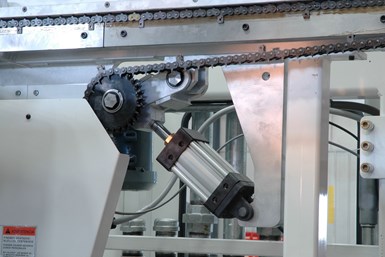
Check pneumatic chain tensioners regularly to avoid uneven tension on continuous thermoformers.
Common Issues to Troubleshoot
Some shot-to-shot misalignment may occur even if the above adjustments to the rail are made. When issues arise, especially today, when OEMs’ technicians can’t travel to service and maintain equipment in person, it can be helpful to have a checklist for troubleshooting.
Here are 10 of the most important steps for troubleshooting misalignment and other common issues in thermoforming.
• Cooling Tubes: Make sure cooling-tube heights are set to twice material thickness, or, for thicker materials, at a maximum of 0.020 to 0.030 in. above the material height. This can be accomplished with a gauge between the top of the chain and the cooling tube.
• Pierce Wheels: Set the pierce wheels at the infeed of the chain rail so the sheet is pushed all the way down onto the pin. This ensures that the sheet is set in correctly, thus eliminating unnecessary stress and premature wear to the chain, saddle, or guidebar.
• Clearances: Keep the distance from the edge of the tool to the chain to a maximum of ½ in. per side, and watch the clearance between the chain rail’s chain-adjuster bolt head and the side of the form tool. Some thicker materials are forgiving and can tolerate wider tolerances, but especially with high-shrink material or a lot of cavities, the narrow gap is imperative.
From the mold to the exit end of the machine, parallel chain rails are imperative.
• Parallel Chain Rails: Be sure to start with the chain rails parallel to the form tool. Each side should have 3/8-in. to ½-in. clearance on the outside of the form tool to the chain on the rail. Chain rails should be set up parallel from the form station stabilizer to the exit end of the machine. If a “V” formation is needed, it should not exceed 2 in., and should be done only from the infeed of the machine to the infeed form-station stabilizer rod. From the mold to the exit end of the machine, parallel chain rails are imperative.
• Chain Stretch: Chains can stretch and wear over time. To check this, first measure a certain number of links (say, 60) at the same spot on each chain. If there is a difference, even a slight one, it’s likely that stretch has occurred. Next, remove both chains from the rails, lay the chain on the floor, and place the pins on the chain facing each other, making sure the chains are pulled tight equally. Measure the chains, and if one is longer than the other or the pins don’t align, replace both.
▪ Stripper-Plate Location: The stripper plate should not extend below the sheet line when stroked, and it should stroke as the platen is retracting. The stripper plate should hold sheet in place and almost appear to stay still as the sheet evacuates the cavities. If the sheet bows upwards, making it hard to strip parts out of the mold, the stripper plate may need adjustment.
▪ Exit-Pan Location: The exit pan between the rails and after the tool should be set at the sheet line. The pan should set so the sheet is not able to sag when indexing out of the mold. Problems occur frequently, especially with thinner materials, if the exit pan is lowered and the sheet doesn’t catch the pan and is bound instead.
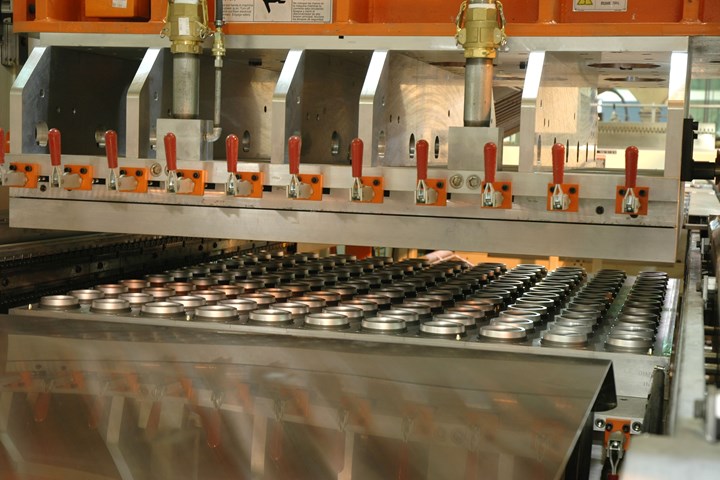
• Sheet Orientation: This can cause issues. To check it, submerge a 6-in.-square piece of material into 400 F cooking oil or place in a 400 F oven. Once heated, measure the difference from the cold to the heated materials both in the index and cross-index directions. Sheet orientation of greater than 10% may cause problems.
• Proper Cooling: Improper cooling in the molds can lead to costly problems, and may be caused by cooling channels getting plugged, running the line too quickly, or using a heat exchanger or chiller with insufficient capacity. One way to determine whether cooling issues are occurring is to check the web temperature with an infrared sensing gun; temperature variance between the front, middle, and back of the sheet should not exceed 5º F.
▪ Centering Chain Rails: Check to ensure the rails are centered. This may be achieved through the use of centerline bars or platen key ways, and a string through the machine marking the center line. There should be the same distance from all adjustment screws to the centerline.
ABOUT THE AUTHOR: Alexx Strobridge began his career as a die setter for injection molding and quickly progressed to a larger company with more than 30 injection presses plus six-axis robotics. After 10 years in injection molding, Strobridge joined Brown Machine Group and currently works in the Tool & Tryout Dept., traveling the world to service thermoforming machines and assist companies by improving their forming processes. Contact: 877-702-4142; brownmachinegroup.com
Related Content
Manufacturer Helps Clean Up Global Waterways with Reclaimed Plastics
RSP and Oceanworks partnership diverts plastic wastes from waterways for incorporation into new products.
Read MoreInteractive Training for Injection, Extrusion and Other Processes
Paulson has four in-booth stations demonstrating its various training solutions.
Read MoreAutomation in Thermoforming on the Rise
Equipment suppliers’ latest innovations exemplify this trend driven by factors such as labor shortages, higher-speed thermoformers and tighter quality control.
Read MoreBrueckner Group USA Moving to Bigger Space
New facility in New Hampshire will serve the local customer base better and enhance capabilities in the North American market.
Read MoreRead Next
Progressive Injection Molder Pioneers in Thermoforming IML
When you’re a successful injection molder with more than 40 years under your belt and more than 50 presses producing 1.8 billion containers and lids for food-packaging containers annually, what do you do when you feel the time is right to expand?
Read MoreFive Big Advances to Track in Thin-Gauge Thermoforming
High speeds, automation, smarter process control, integrated vision systems, and better decoration techniques are becoming more common among practitioners of the ‘black art’ of thermoforming. Are they for you?
Read MoreThermoforming PLA: How to Do It Right
Polylactic acid (PLA) resins are made from 100% renewable resources such as corn, sugar beets, or sugarcane.
Read More

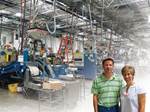

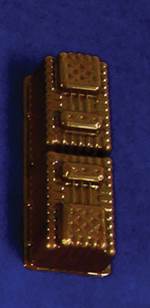
















.png;maxWidth=300;quality=90)


